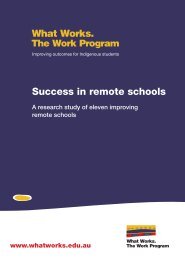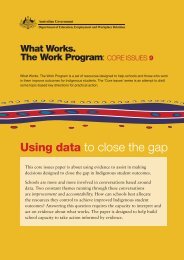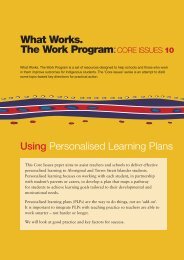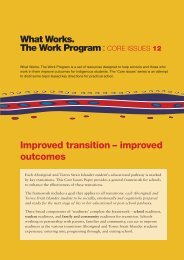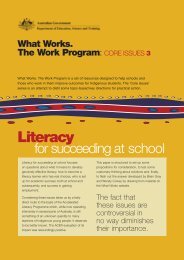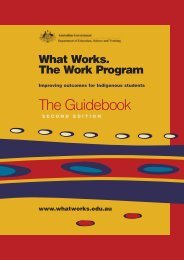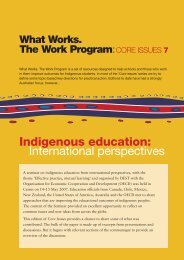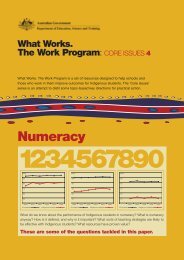MATHEMATICSNumberConcept In Year 1the student:In Year 2the student:In Year 3the student:In Year 4the student:In Year 5the student:In Year 6the student:In Year 7the student:In Year 8the student:In Year 9the student:• Skip counts in 2s to 10,<strong>for</strong>wards <strong>and</strong> backwards• Skip counts in 2s, 5s, 10sto 100• Skip counts in 2s,5s, 10s to100 <strong>and</strong> relates this tomultiplication (e.g. says“five, ten, fifteen, twenty isfour lots of 5”)• Uses the patterns in ahundreds chart to helpunderst<strong>and</strong> multiplicationtables (up to 10 x 10) <strong>and</strong>knows that because of theproperty of commutativityof multiplication (i.e. a x b= b x a) they only have tolearn half of them• Knows what factors <strong>and</strong>multiples are <strong>for</strong> 2 <strong>and</strong> 3-digit numbers (e.g. knowsthe first six multiples of 25<strong>and</strong> the factors of 80)• Knows that ‘25% off’ thefull price means theywould save ¼ of the price<strong>and</strong> that ‘50% off’ meansthey would save half thefull price; knows <strong>and</strong> canshow that 50% of ahundreds square meansthat 50 of the 100 squaresare shaded <strong>and</strong> they canbe any 50 of the squares• Knows <strong>and</strong> can show on ahundreds square that 12/20as a percentage is 12 out ofevery 20 squares on thehundreds square; calculateswith fractions <strong>and</strong>percentages based onmultiples of 10% <strong>and</strong> 25%of a given unit or quantity(e.g. 60% of a 1 kg bag ofnuts; what proportion of 2 Ljuice bottle is mango juiceif 30% is mango juice)• Uses a calculator toexpress one quantity as a% of another <strong>and</strong> to findfractions <strong>and</strong> percentagesof numbers (e.g. can find38% of 4 500) estimatingfirst to gain a sense of thereasonableness of theanswer produced; Recordsstages of findingpercentages of quantitieswhich they cannot findmentally (e.g. finds 20% of384 by writing !0% of 384= 38.4 <strong>and</strong> doubles that toget 20% is 3.8.4 + 38.4 =76.8)• Critically interpretspublished percentages bydeciding what the ‘whole’is first (e.g. knows what‘increased by 200%’means <strong>and</strong> determineswhether it is correctly usedin an advertisement);knows how to increasenumbers by a percentageusing a calculator (e.g.knows that to increase avalue by 20% they need tomultiply it by 1.2)• Uses technology <strong>for</strong> singleoperations involving singledigit numbers (e.g. presses‘4’ ‘+’ ‘2’ ‘=’ on a simplecalculator)• Uses technology <strong>for</strong> singleoperations involving 2-digit numbers <strong>and</strong> explainswhat they have done• Uses technology <strong>for</strong> singleoperations involving 2 <strong>and</strong>3-digit numbers <strong>and</strong>explains what they havedone• Uses technology <strong>for</strong> singleoperations <strong>for</strong> 2 <strong>and</strong> 3-digitnumbers <strong>and</strong> explains whatthey have done <strong>and</strong> found• Uses technology includinga calculator <strong>for</strong> singleoperations <strong>and</strong> explains<strong>and</strong> shows what they havedone <strong>and</strong> found (e.g.knows that 3 x 15 is threelots of 15 <strong>and</strong> can prove itby adding 15 + 15 + 15);uses a calculator to divide<strong>and</strong> knows that 4)35 isentered as 35 ÷ 4• Underst<strong>and</strong>s the ‘rule o<strong>for</strong>der’ <strong>for</strong> +, -, x, ÷ (ie,that in a string ofoperations, multiplication<strong>and</strong> division are done firstin the order in which theyoccur; 2+4 x 3 will bedone as 4 x 3 <strong>and</strong> 2 addedto the result); can explorewhether their calculatorfollows this rule of orderor not <strong>and</strong> explains howthey know; Can use thememory to store the resultof 4 x 3 <strong>and</strong> adds thenumber stored to 2 if theircalculator doesn’t use therule of order• Uses a calculator orspreadsheet to carry outcomplex repetitivecomputations, payingattention to rule of order(order of operations) (e.g.adds amounts <strong>for</strong> itemsfrom a mail order catalogue<strong>and</strong> includes GST <strong>and</strong>postage); uses a calculatorto carry out <strong>and</strong> checkcalculations involvingrational numbers <strong>and</strong>justifies the size of theanswer (e.g. 4¾ - 2 1/3 =2.41666…) based onknowledge of the operation<strong>and</strong> the numbers used; usesa calculator memory orbrackets to calculateexpressions such as (4.1 x1.2) + (3.5 x 3)• Plans <strong>and</strong> explains asequence of calculationsusing a calculator memoryfacility when there are nobrackets on the calculator(e.g. to calculate (2.358 x3.5) + 2.4 3 ) plans toexecute the calculation as2.358 x 3.5 saving theanswer in their calculatormemory, clearing, finding2.4 x 2.4 x 2.4 <strong>and</strong> thenadding their result to thenumber stored in thecalculator memory, <strong>and</strong>explains this sequence oftheir activities)• Uses technologicalcalculation tools to carryout efficient computations(e.g. √(27.4 3 – 18.6 2 , $4800 x (1.05) 10 to calculatecompound interest) givinganswers to a reasonablelevel of accuracy; Carriesout, with technology,computations involvingdecimal approximations toirrational numbers inmeasurement contexts <strong>and</strong>to given degrees ofaccuracy (e.g. says ” thediagonal of a rectanglewith side lengths 10m <strong>and</strong>5m is √125 ≈ 11.18 or 1.2metres to one degree ofaccuracy” <strong>and</strong> “a circlewith a circumference of100 m has a diameter of100 ÷ π which is about31.8 metres”)• Identifies additionsituations from simplenumber stories (e.g. the 3bears) <strong>and</strong> draws a pictureto represent the situation• Identifies addition <strong>and</strong>subtraction situations fromsimple number stories;writes simple stories aboutsingle operations (e.g. <strong>for</strong>the operation 5 – 3, writes“there were 5 baby turtles<strong>and</strong> 3 of them got eaten bythe birds”)• Represents mathematicalquestions using objects orpictures or symbols orparaphrasing (e.g. whentold there were 5 babyturtles <strong>and</strong> 3 of them goteaten by the birds, writes 5– 3)• Interprets (<strong>and</strong> creates)problems based around asingle operation <strong>and</strong>decide which operation isrequired; +, -, x, ÷ (e.g. <strong>for</strong>“20 lollies are sharedequally between 4 boys;how many will they eachget?” can determine thatsharing is needed to solve)• Explains <strong>and</strong> comparesstrategies <strong>for</strong> solvingsimple problems (e.g. says“I gave out the 20 lolliesone at a time to eachperson until I ran out, butNatalie did it another waysheput the lollies in littlegroups on the table”)• Reads <strong>and</strong> interpretspractical problems,identifies which operation(+, -, x, ÷) to use,expresses itmathematically <strong>and</strong> thensolves it• Reads <strong>and</strong> interpretspractical problems,identifies which operation(+, -, x, ÷) to use,expresses itmathematically <strong>and</strong> thensolves it, making sure theiranswer makes sense in thecontext• Reads <strong>and</strong> interpretspractical problems,identifies which operationto use, expresses itmathematically <strong>and</strong> thensolves it, making suretheir answer makes sensein the context, <strong>and</strong>explains their choice ofoperation• Interprets problemsituations to choose <strong>and</strong> usean appropriate sequence ofoperations <strong>and</strong> appliessuitable methods ofcomputation (e.g. choosesto calculate a 20% discountusing multiplication <strong>and</strong>subtraction)• Uses a number line ormaterials to solve practicalproblems involving addition<strong>and</strong> subtraction of integers(e.g. uses a number line toshow that an overnighttemperature drop of 12°Cfrom 5°C results in aminimum of -7°C)• Recognises <strong>and</strong> in<strong>for</strong>mallyexplain negatives whichmay appear on a calculatordisplay when somesubtractions are carried outin a context (e.g. whenusing a calculator to findhow much more they needto pay if they’ve paid 156out of 234 explains whythe display shows -78 ifthey enter ‘156 – 234’ inerror); Knows how to usethe ‘+/-‘ key on acalculator when entering asubtraction <strong>and</strong>erroneously entering thesmaller number first• Underst<strong>and</strong>s the sequenceof operations used bysimple technologies (e.g. a4-function calculator) maydiffer <strong>and</strong> checks <strong>and</strong>interprets these when usingthem; Is able to explain thesequence of operationsneeded to duplicate thesequence of operationsused by a calculator (e.g.says “to show using acalculator that (3 x 4) ÷(2 x 6) is equal to one Ineed to press the ÷ keytwice since I’m dividing by2 <strong>and</strong> by 6”)<strong>Bound</strong> <strong>for</strong> <strong>Success</strong> <strong>Scope</strong> <strong>and</strong> <strong>Sequence</strong> <strong>Statements</strong> V2 Page 33 Working Document Semester One 2007
MATHEMATICSNumberConcept In Year 1the student:In Year 2the student:In Year 3the student:In Year 4the student:In Year 5the student:In Year 6the student:In Year 7the student:In Year 8the student:In Year 9the student:• Underst<strong>and</strong>s thecommutativity <strong>and</strong>associativity of addition<strong>and</strong> multiplication <strong>and</strong>uses these properties toassist in their calculations(e.g. 12 + 15 = 15 + 12)<strong>and</strong> in learning their tables(e.g. 6 x 4 = 4 x 6 so I onlyhave to know 6 x 4)• Applies the commutative,associative <strong>and</strong> distributiveproperties to help withtheir calculations <strong>and</strong>chooses whether tocalculate using mental,written or calculator/othertechnology methods or acombination of these, <strong>and</strong>explains their methods• Applies the commutative,associative <strong>and</strong>distributive properties tohelp with theircalculations <strong>and</strong> chooseswhether to calculate usingmental, written orcalculator/othertechnology methods or acombination of these <strong>and</strong>explains their methods(e.g. knows that 5 x 26 isthe same as 5 x (20 + 6)which is (5 x 20) + (5 x6), <strong>and</strong> having written thisdown is able to calculatethe answer mentally• Applies commutative <strong>and</strong>associative properties toexpressions to exploregeneral mathematicalproperties of numbers (e.g.shows how 6 lots of 15 000could be calculated as 3 lotsof 30 000 <strong>and</strong> generalisesthis principle to othercalculations including 6 x12 = 3 x 24; says “if I halveone number <strong>and</strong> double theother one then multiply, Iget the same answer”) <strong>and</strong>knows that this can bewritten as n x m = 2 x n x ½x m where n <strong>and</strong> mrepresent any two numbers• Can explain usingmaterials, the associative<strong>and</strong> commutativeproperties <strong>for</strong>multiplication <strong>and</strong> additionto their peers usingspecific examples <strong>and</strong> thengeneralising to show that itworks every time (e.g. usesa 3 by 5 array of blocks toshow that 3 rows of 5blocks will always be 15blocks <strong>and</strong> that 5 rows of 3blocks will be the same);explains using diagrams orthe same methods whysubtraction <strong>and</strong> divisionare not commutative.• Applies commutative <strong>and</strong>associative propertieswhen calculating mentally(e.g. says “29 x 7 is thesame as 20 x 7 plus 9 x 7which is 140 plus 63 whichis 203”)• Rounds small decimalnumbers up or down to thenearest 10 to facilitatecalculation <strong>and</strong> knowswhich two whole numbersthe answer will be between<strong>and</strong> explains why (e.g.says “2.1 x 4.5 will bebetween 8 <strong>and</strong> 10 because2 x 4 is less than 2 x 5”)• Uses rounding <strong>and</strong>powers of ten to estimatecalculations (e.g.estimates 43.7 x 531 to beabout 40 x 500 which is20 000) <strong>and</strong> knowswhether the estimate willbe more or less than thereal answer because of thedirection of the roundingwhen both numbers arerounded up or both arerounded down (e.g. says“it will really be morethan 20 000 since Irounded both numbersdown”)• Estimates the result of asimple calculationinvolving whole numbers,decimals <strong>and</strong> fractionsarising from a practicalsituation (e.g. total from ashopping bill, mean of asmall set of numbers <strong>and</strong>proportion of a quantityincluding 3/5 of a 44 Lcooler) <strong>and</strong> interprets <strong>and</strong>justifies their reasoning(e.g. says “it will cost aboutten dollars because the firstitem is about 2 dollars, thesecond is about 4 dollarsfifty cents <strong>and</strong> the third isabout 3 dollars fifty”)• Estimates the result of acalculation based on theirknowledge of numbers <strong>and</strong>operations, <strong>and</strong> justifiestheir estimate (e.g.estimates that 38 x 495will be about 40 x 500which is 4 x 5 with threezeros saying “the answerwill be in the thous<strong>and</strong>sbecause tens multiplied byhundreds givesthous<strong>and</strong>s”)• Finds upper <strong>and</strong> lowerestimates <strong>for</strong> calculations,<strong>for</strong>ms closer estimateswithin this interval <strong>for</strong>computation in a givencontext (e.g. <strong>for</strong> splitting arestaurant bill betweenseveral people); Formsestimates <strong>for</strong> square roots(e.g. says “√500 isbetween 20 <strong>and</strong> 30because the square root of400 is 20 <strong>and</strong> 30 squaredis 900” <strong>and</strong> “ 2 times π is abit more than 6 because πis just more than 3”);Chooses a suitable level ofaccuracy <strong>for</strong> a calculationdepending on the context<strong>and</strong> reason <strong>for</strong> calculating(e.g. to order a load ofmulch <strong>for</strong> a garden theywould use cubic metres<strong>and</strong> not litres or metres)<strong>Bound</strong> <strong>for</strong> <strong>Success</strong> <strong>Scope</strong> <strong>and</strong> <strong>Sequence</strong> <strong>Statements</strong> V2 Page 34 Working Document Semester One 2007



